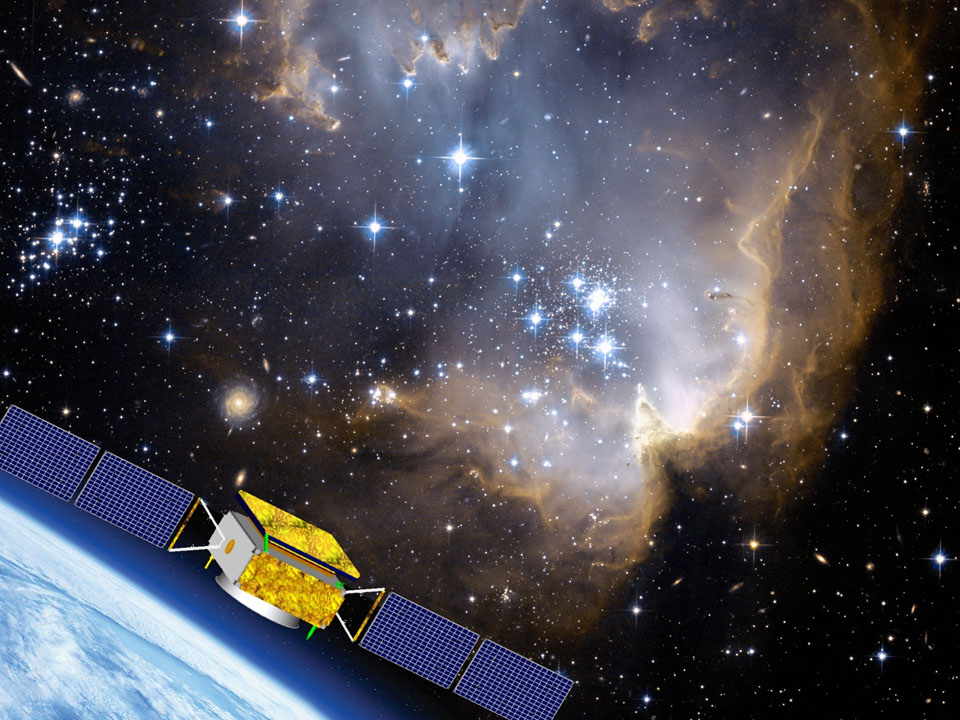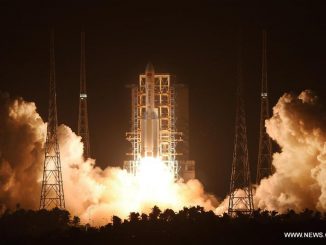China launched the first in a series of planned space science probes Thursday, putting a satellite into orbit to study high-energy cosmic rays for signals hinting at hypothesized clumps of dark matter that have eluded detection for decades.
The Dark Matter Particle Explorer, or DAMPE, mission is the first dedicated astrophysics observatory put into orbit by China.
Fitted with detectors sensitive to gamma rays, electrons and high-energy cosmic rays, the DAMPE satellite will scoop up particles speeding through the cosmos and measure their energy, direction and electric charge, according to mission scientists.
Researchers hope the measurements hold clues in the search for dark matter, perhaps even the signature of a process called annihilation, a phenomenon physicists believe is caused when two subatomic particles collide and give off a burst of radiation.
Cosmic rays that could be emitted from annihilation events streak across the universe at nearly the speed of light, and instruments like the sensors on DAMPE could find subtle signals hidden within the high-energy particles traceable back to a dark matter origin.
The 1.9-metric ton (4,200-pound) DAMPE satellite rode a Chinese Long March 2D booster into orbit from the Jiuquan space center in northwest China’s Inner Mongolia autonomous region.
The rocket blasted off at 0012 GMT Thursday (7:12 p.m. EST Wednesday), or around dawn at the launch site.
It entered an orbit about 500 kilometers, or 310 miles, above Earth, flying over the poles on each trip around the planet.
DAMPE’s mission should last at least three years, and perhaps as long as five years, according to China’s state-run Xinhua news agency.

Scientists calculate dark matter makes up about 85 percent of the mass of the universe, yet it remains undetected and a subject of intrigue in the astrophysics community.
Astronomers observing the movements of visible matter, like galaxies and stars, noticed behavior that must be attributed to the pull of unseen matter lurking throughout the cosmos, giving rise to the well-established theory that dark matter is ubiquitous in the universe.
Other experiments are on the hunt for dark matter, such as the Alpha Magnetic Spectrometer attached to the International Space Station. DAMPE will look for signals in a new higher energy range so far unexplored, scientists said.
Physicists also study dark matter in giant particle colliders and with vast underground detectors.
Scientists from institutions in China, the University of Geneva, and universities in Perugia, Bari and Lecce, Italy, are working on the DAMPE mission.
“The main scientific objective of DAMPE is to measure electrons and photons with much higher energy resolution and energy reach than achievable with existing space experiments in order to identify possible dark matter signatures,” scientists wrote in a description of the mission on the University of Geneva’s website. “It has also great potential in advancing the understanding of the origin and propagation mechanism of high energy cosmic rays, as well as in new discoveries in high energy gamma astronomy.”
Chinese officials announced Wednesday the DAMPE mission would be nicknamed Wukong after a global naming campaign garnered 32,000 name suggestions. Wukong is a fictional monkey king in the Chinese fairy tale “Journey to the West.”
Chang Jin, chief scientist on the DAMPE mission, told China’s Xinhua news agency that the satellite will scan the entire sky for the first two years of its life, then focus on areas where scientists believe dark matter is most likely to exist.
“We have not entirely figured out the physical properties of dark matter, so no one is one hundred percent sure that the satellite can find it,” said Chang, who is also vice director of the Purple Mountain Observatory in Nanjing, China. “As long as Wukong keeps working, it will open a new window for our search.”
Email the author.
Follow Stephen Clark on Twitter: @StephenClark1.



